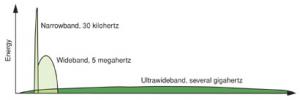InfrastructureUnderground radar locates post-Katrina damage
An innovative underground radar technology is helping a city of in south Louisiana to identify and document underground infrastructure damage that had gone undetected in the months and years following Hurricane Katrina. This radar technology is a pipe-penetrating scanning system based on a new technology called ultra-wide band (UWB) pulsed radar. UWB allows for the inspection of buried pipelines, tunnels, and culverts to detect fractures, quantify corrosion, and determine the presence of voids in the surrounding soil often caused by storm water leaks and flooding.

Illustration of ultrawideband's range of funtionality // Source: linl.gov
An innovative underground radar technology developed at Louisiana Tech University is helping the City of Slidell in south Louisiana to identify and document underground infrastructure damage that had gone undetected in the months and years following Hurricane Katrina. This radar technology is a pipe-penetrating scanning system based on a new technology called ultra-wide band (UWB) pulsed radar. UWB allows for the inspection of buried pipelines, tunnels, and culverts to detect fractures, quantify corrosion, and determine the presence of voids in the surrounding soil often caused by storm water leaks and flooding.
LSU says that this technology, developed at Louisiana Tech’s Trenchless Technology Center, incorporates leading-edge simulation, electronics, robotics, signal processing and three-dimensional (3-D) renderings in a package that can be mounted on existing pipe-inspection robots.
Dr. Arun Jaganathan, associate professor of civil engineering and construction engineering technology at Louisiana Tech, began developing this technology as the basis for his Ph.D. dissertation research. Partnering with fellow Louisiana Tech researcher Dr. Neven Simicevic and others, his vision was to eventually develop it into a tool that municipal engineers can use for their routine pipeline condition assessment.
“Our UWB technology was based on recognizing the need within the trenchless industry for an advanced pipeline inspection tool that can quantify the structural integrity of buried municipal pipes like sewers and storm drains, and be able to see through the pipe wall,” said Jaganathan. “The radar system emits ultra-short electromagnetic pulses from inside of a sewer pipe and captures the signals ‘back-scattered’ from the pipe to determine the condition of various layers hidden behind the wall which we cannot directly see using visual tools such as a camera. The radar is integrated into a robot which crawls through a pipe and relays the data back to the operator in real time.”
Jay Newcomb, City of Slidell Council Member for District F and a Louisiana Tech alumnus, learned of this technology and the possibilities for partnership through his connections with his alma mater.
“During my campaign for City Council, myself, and many others all espoused a need in the city for small, high tech, clean industry,” said Newcomb. “I was already well aware of what Tech was doing with the business incubator on campus and, though we have no university to attach an incubator to, we took a trip to Tech in September of 2010 to check things out and make ourselves be known to any interested companies.
